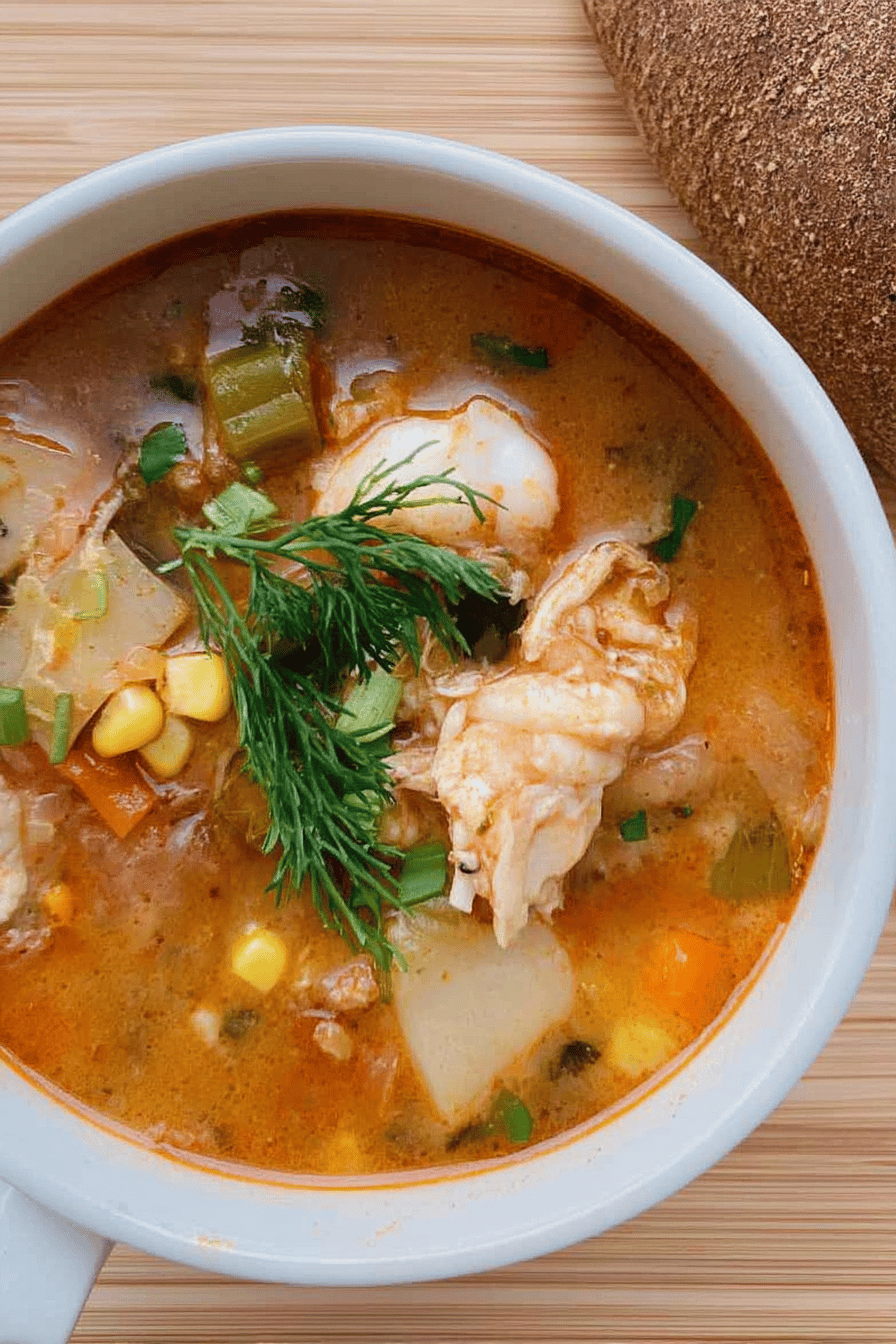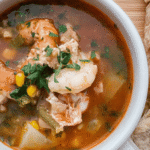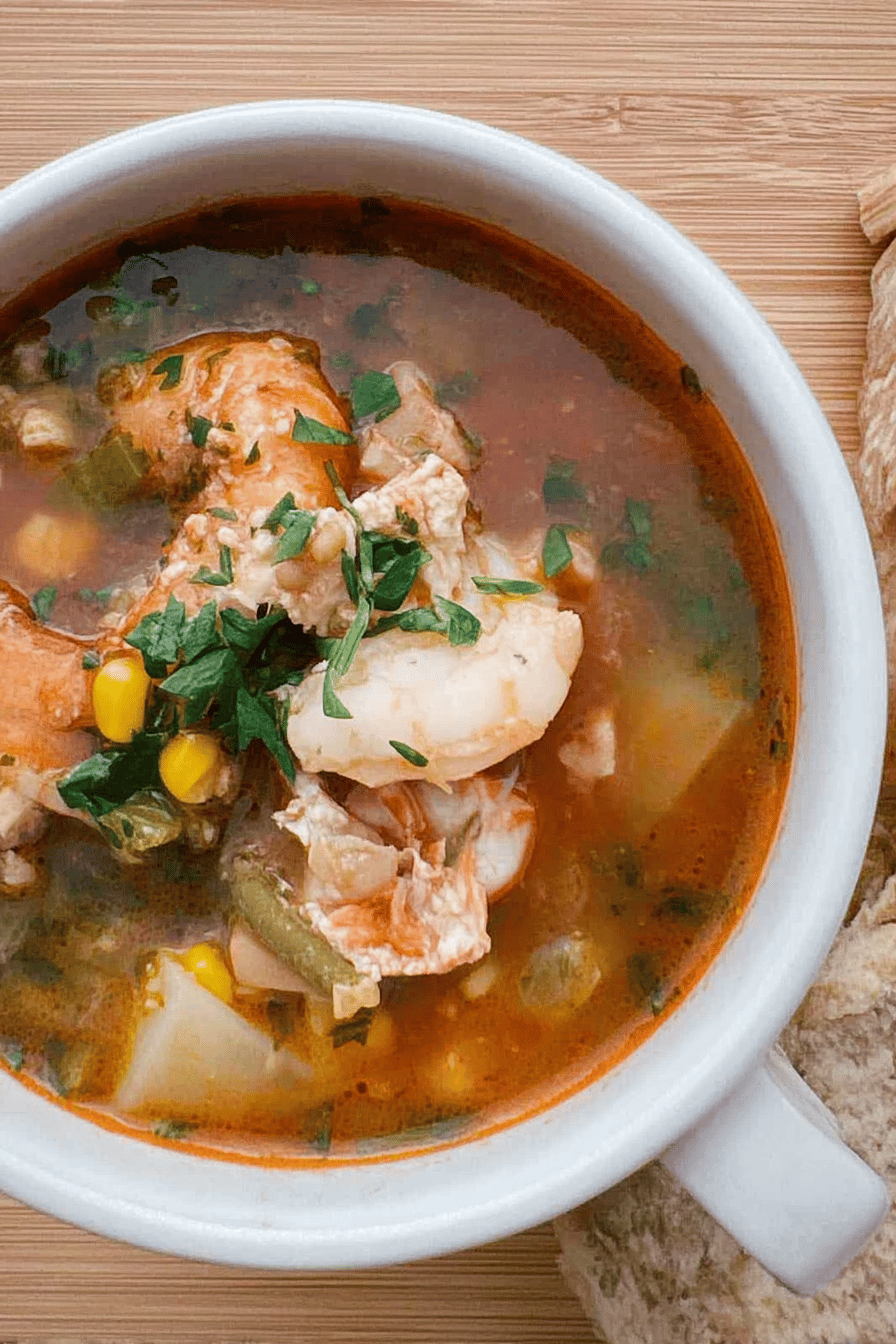Why You’ll Love This Seafood Soup
- Ease of preparation: This seafood soup recipe is straightforward and quick to prepare, perfect for busy weeknights or cozy weekend dinners. With simple steps and easily sourced ingredients, it takes under 30 minutes active cooking time, making it accessible for cooks of all levels.
- Health benefits: Packed with lean protein from fresh seafood like fish, shrimp, and scallops, this soup delivers essential omega-3 fatty acids, vitamins, and minerals. It supports heart health, boosts immunity, and contributes to overall wellness without excess calories or fat.
- Versatility: Easily adapted to various dietary needs, this seafood soup can be made gluten-free by using gluten-free stock and seasonings, or vegan by substituting seafood with tofu and vegetable broth. The recipe allows ingredient swaps to suit preferences and nutritional goals.
- Distinctive flavor: The combination of fresh seafood, aromatic herbs like thyme and parsley, a rich broth, and subtle spices such as Old Bay seasoning creates a comforting and memorable taste experience that stands out from typical soups.
Jump To
- 1. Why You’ll Love This Seafood Soup
- 2. Essential Ingredients for Seafood Soup
- 3. How to Prepare the Perfect Seafood Soup: Step-by-Step Guide
- 4. Dietary Substitutions to Customize Your Seafood Soup
- 5. Mastering Seafood Soup: Advanced Tips and Variations
- 6. How to Store Seafood Soup: Best Practices
- 7. FAQs: Frequently Asked Questions About Seafood Soup
- 8. seafood soup
Essential Ingredients for Seafood Soup
- 2 pounds assorted fish (e.g., salmon fillet, haddock, cod), skin removed if needed – forms the flavorful seafood base
- 1 pound raw shrimp, peeled and deveined – adds tender texture and protein
- 0.5 pound scallops (optional) – provides delicate sweetness and richness
- 1 cup imitation crab meat, diced (optional) – adds variety and mild seafood flavor
- 2 tablespoons olive oil – used for sautéing vegetables and adds depth
- 1 cup diced celery (optional) – offers crunch and freshness
- 1 cup diced onions (about 1 medium onion) – builds aromatic base
- 1 cup diced carrots (about 1 large carrot) – contributes natural sweetness and color
- 2 cups diced potatoes (about 3 large Yukon Gold or similar) – adds heartiness
- 1 cup diced zucchini – introduces mild flavor and texture
- 1 cup corn kernels (fresh or frozen) – adds sweetness and pop of color
- 2 cups plum or crushed tomatoes – imparts acidity and body to broth
- 2 quarts chicken stock or a mix of water and stock – forms the soup base with rich flavor
- 1 tablespoon Old Bay seasoning or equivalent seafood seasoning – enhances the seafood essence
- 1 tablespoon salt (adjust to taste) – balances overall flavor
- ½ teaspoon black pepper – adds mild heat and depth
- 1 tablespoon fresh thyme, finely chopped – fresh herbaceous note
- 1 tablespoon Italian parsley, chopped (for garnish) – fresh finish
- Optional: 2–3 garlic cloves, minced – boosts aroma and complexity
- Optional: splash of white wine – adds brightness and sophistication
- Optional garnishes: green onions, fresh cilantro, or hot sauce/red pepper flakes for spice – customizable flavor boosters
Special Dietary Options:
- Vegan: Substitute seafood with tofu or jackfruit and use vegetable broth instead of seafood or chicken stock.
- Gluten-free: Use gluten-free broth and check all seasonings to avoid gluten-containing ingredients.
- Low-calorie: Use minimal olive oil and increase vegetables for a lighter, nutrient-dense version.
How to Prepare the Perfect Seafood Soup: Step-by-Step Guide
First Step: Prepare Ingredients
Wash and dice all vegetables: celery, onions, carrots, potatoes, and zucchini. Peel and devein shrimp if not prepped. Cut fish into bite-sized chunks. If using frozen seafood, thaw completely.
Second Step: Sauté Vegetables
In a large pot, heat 2 tablespoons olive oil over medium-high heat. Add diced celery (if using), onions, carrots, and optional garlic. Sauté for 3-4 minutes until softened and aromatic.
Third Step: Add Potatoes, Zucchini, and Corn
Stir in diced potatoes, zucchini, and corn. Cook for 5-10 minutes, reducing heat to low. Continue cooking for 10-15 minutes more to deepen vegetable flavors.
Fourth Step: Add Liquids and Seasonings
Pour in the chicken stock or mixture of water and stock, then add diced tomatoes, Old Bay seasoning, salt, black pepper, and chopped thyme. Bring to a boil, then reduce heat and simmer for 30-40 minutes to develop the broth’s richness.
Fifth Step: Add Seafood
Carefully add the fish pieces to the pot. Simmer for 20-40 minutes, depending on the fish’s thickness, until fully cooked. Add shrimp, crab meat, and scallops (if using) during the last 10-20 minutes to keep them tender and avoid overcooking.
Sixth Step: Season and Taste
Check seasoning and adjust salt, pepper, or Old Bay. Add a splash of white wine for extra flavor, if desired. Let the soup simmer a few minutes more if needed.
Final Step: Garnish and Serve
Serve the seafood soup hot, garnished with fresh Italian parsley and optional green onions or cilantro. Accompany with crusty bread, garlic bread, or a fresh salad for a complete meal.
Dietary Substitutions to Customize Your Seafood Soup
Protein and Main Component Alternatives
- Replace shrimp and scallops with tofu or tempeh for vegan or plant-based versions.
- Use chicken breast or turkey for those preferring poultry over seafood.
- Swap fish varieties, such as using cod, halibut, or haddock, to change flavor or texture as preferred.
Vegetable, Sauce, and Seasoning Modifications
- Replace celery and carrots with zucchini, bell peppers, or green beans depending on season and taste.
- Use vegetable broth instead of seafood or chicken stock for vegetarians and vegans.
- Alter herbs and spices by adding dill, parsley, paprika, or chili flakes for flavor variations.
- Omit spicy ingredients or reduce Old Bay seasoning for milder tastes.
Mastering Seafood Soup: Advanced Tips and Variations
- Pro cooking techniques: Use a gentle simmer throughout to prevent overcooking delicate seafood, preserving tender texture.
- Flavor variations: Add saffron threads for subtle aroma, or coconut milk for a creamy, tropical touch. Smoke paprika or chili flakes can introduce smoky or spicy nuances.
- Presentation tips: Serve in heated bowls garnished with chopped parsley, lemon zest, or a drizzle of quality olive oil. Include toasted artisan bread for a hearty accompaniment.
- Make-ahead options: Prepare broth and sauté vegetables ahead, storing separately from seafood. Add seafood and reheat gently before serving to maintain freshness and texture.
How to Store Seafood Soup: Best Practices
Refrigeration
Store seafood soup in airtight containers in the refrigerator and consume within 2 days to ensure maximum freshness and safety.
Freezing
Freeze cooled soup in freezer-safe containers for up to 3 months. Avoid freezing cooked seafood separately to protect texture and flavor.
Reheating
Thaw frozen soup overnight in the refrigerator and reheat gently over medium heat, stirring occasionally to prevent overcooking.
Meal Prep Considerations
Prepare large batches of broth and vegetables, freezing in portions. Add fresh seafood when ready to serve for the best taste and texture.

FAQs: Frequently Asked Questions About Seafood Soup
What types of seafood work best in seafood soup?
Most fish and shellfish can be used in seafood soup depending on your preference. Firm white fish like cod, haddock, or halibut hold their shape well, while flaky fish break down into tender pieces as the soup cooks. Shellfish such as shrimp, scallops, clams, and mussels add texture and flavor but can be omitted if you have allergies or don’t enjoy them. Cut fish into bite-sized pieces for even cooking. Combining a variety of seafood can create a richer taste and appealing texture.
How should I prepare seafood before adding it to the soup?
Fresh or properly thawed seafood is essential for best results. Devein shrimp by making a shallow cut along the back and removing the dark vein, then rinse under cold water. Fish should be cut into manageable pieces, removing bones if possible. Shellfish like clams and mussels should be scrubbed and debearded. Adding seafood towards the end of cooking helps prevent overcooking and maintains a tender texture.
Can I add alcohol like white wine to seafood soup, and how does it affect the flavor?
Yes, white wine is commonly added to seafood soups to add depth and brightness to the flavor. A splash of dry white wine complements the seafood’s natural taste and can enhance the aroma. Add the wine early in the cooking process to let the alcohol cook off while retaining its flavor components. Alternatively, modifying the soup with ingredients like coconut milk or herbs can create different regional variations.
What’s the best way to store and reheat leftover seafood soup?
Store leftover seafood soup in an airtight container in the refrigerator for up to 3-4 days. Reheat only the portion you plan to eat to avoid repeated reheating, which can toughen seafood. Reheat gently on the stovetop over medium heat, stirring occasionally until just warmed. If using a microwave, heat in short bursts with stirring between intervals to prevent overcooking. This approach keeps seafood tender and preserves flavors.
Is it safe and effective to freeze seafood soup for later use?
Seafood soup can be frozen for up to 3 months when cooled completely and stored in freezer-safe containers or bags. For best texture, avoid freezing soups with dairy or delicate seafood for prolonged periods. When ready to use, thaw the soup overnight in the refrigerator or reheat it gently from frozen on the stove over low to medium heat until hot. This method helps preserve taste while preventing seafood from becoming rubbery.

seafood soup
- Total Time: 1 hour 20 minutes
- Yield: 6 servings
- Diet: Gluten-Free
Description
🍲 Seafood Soup offers a hearty, nutritious meal packed with a variety of seafood and fresh vegetables for rich flavor.
🦐 This versatile recipe balances protein and veggies, perfect for a satisfying and comforting dining experience any time of year.
Ingredients
– 2 pounds assorted fish forms the flavorful seafood base
– 1 pound raw shrimp adds tender texture and protein
– 0.5 pound scallops provides delicate sweetness and richness
– 1 cup imitation crab meat adds variety and mild seafood flavor
– 2 tablespoons olive oil used for sautéing vegetables and adds depth
– 1 cup diced celery offers crunch and freshness
– 1 cup diced onions builds aromatic base
– 1 cup diced carrots contributes natural sweetness and color
– 2 cups diced potatoes adds heartiness
– 1 cup diced zucchini introduces mild flavor and texture
– 1 cup corn kernels adds sweetness and pop of color
– 2 cups plum or crushed tomatoes imparts acidity and body to broth
– 2 quarts chicken stock forms the soup base with rich flavor
– 1 tablespoon Old Bay seasoning enhances the seafood essence
– 1 tablespoon salt balances overall flavor
– ½ teaspoon black pepper adds mild heat and depth
– 1 tablespoon fresh thyme fresh herbaceous note
– 1 tablespoon Italian parsley for garnish
– 2–3 garlic cloves boosts aroma and complexity
– splash of white wine adds brightness and sophistication
– green onions for garnishes
– fresh cilantro for garnishes
– hot sauce for spice
– red pepper flakes for spice
Instructions
1-First Step: Prepare IngredientsWash and dice all vegetables: celery, onions, carrots, potatoes, and zucchini. Peel and devein shrimp if not prepped. Cut fish into bite-sized chunks. If using frozen seafood, thaw completely.
2-Second Step: Sauté VegetablesIn a large pot, heat 2 tablespoons olive oil over medium-high heat. Add diced celery (if using), onions, carrots, and optional garlic. Sauté for 3-4 minutes until softened and aromatic.
3-Third Step: Add Potatoes, Zucchini, and CornStir in diced potatoes, zucchini, and corn. Cook for 5-10 minutes, reducing heat to low. Continue cooking for 10-15 minutes more to deepen vegetable flavors.
4-Fourth Step: Add Liquids and SeasoningsPour in the chicken stock or mixture of water and stock, then add diced tomatoes, Old Bay seasoning, salt, black pepper, and chopped thyme. Bring to a boil, then reduce heat and simmer for 30-40 minutes to develop the broth’s richness.
5-Fifth Step: Add SeafoodCarefully add the fish pieces to the pot. Simmer for 20-40 minutes, depending on the fish’s thickness, until fully cooked. Add shrimp, crab meat, and scallops (if using) during the last 10-20 minutes to keep them tender and avoid overcooking.
6-Sixth Step: Season and TasteCheck seasoning and adjust salt, pepper, or Old Bay. Add a splash of white wine for extra flavor, if desired. Let the soup simmer a few minutes more if needed.
7-Final Step: Garnish and ServeServe the seafood soup hot, garnished with fresh Italian parsley and optional green onions or cilantro. Accompany with crusty bread, garlic bread, or a fresh salad for a complete meal.
Notes
🦞 Use shrimp shells and fish scraps to make homemade seafood stock for deeper flavor.
🥕 Sauté vegetables before adding liquid to enhance their natural sweetness.
⏲️ Add seafood at staggered intervals to avoid overcooking; scallops 20 minutes before end, shrimp last 10 minutes.
- Prep Time: 20 minutes
- Simmer Time: 40 minutes
- Cook Time: 1 hour
- Category: Soup
- Method: Sautéing, Simmering
- Cuisine: American
Nutrition
- Serving Size: 1.5 cups
- Calories: 290 kcal
- Sugar: 5 g
- Sodium: 1125 mg
- Fat: 9 g
- Saturated Fat: 1.5 g
- Unsaturated Fat: 6 g
- Trans Fat: 0 g
- Carbohydrates: 22 g
- Fiber: 2.5 g
- Protein: 30 g
- Cholesterol: 90 mg
Keywords: Seafood Soup, Shrimp, Steak, Stir Fry



This seafood soup was fantastic! 🦐 I added a splash of coconut milk for a little creaminess, and it turned out amazing. Definitely a keeper for chilly nights!
★★★★★